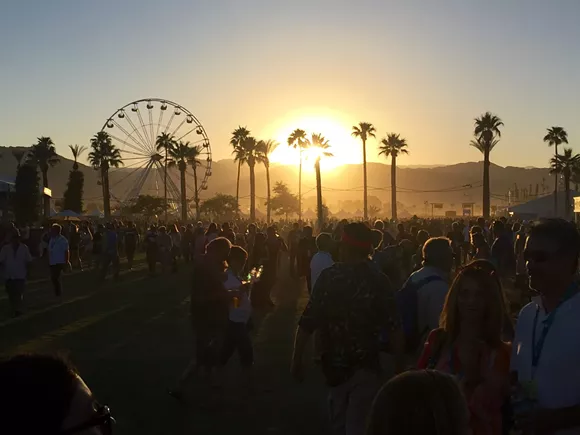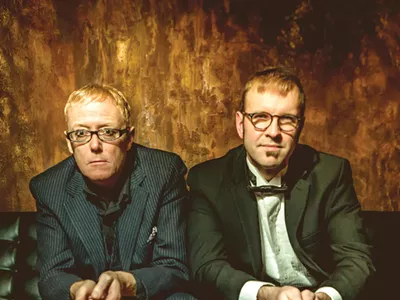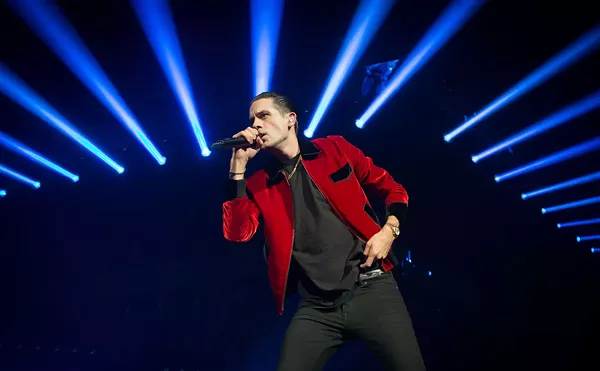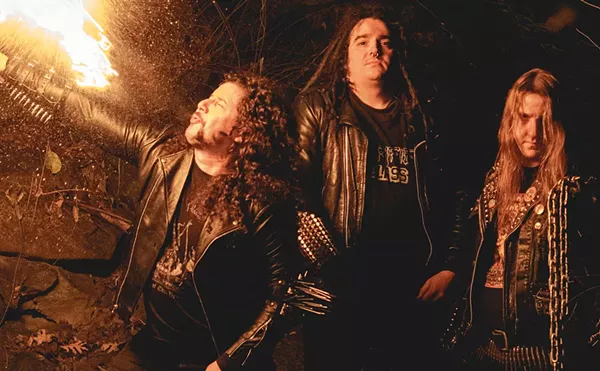Indio, Calif. — After the first of two weekends of performances by rock ‘n’ roll royalty, the Desert Trip festival can claim spiritual victory, 1-0, over the insidious force that threatened to overshadow it: Nostalgia.
With a lineup of performers entirely in their 70s, weekend passes ranging between $399 and $1,599, and setlists certain to be stacked with greatest hits, it could have easily been a three-day cliché — and still have left the audience satisfied.
But the artists themselves — Bob Dylan, The Rolling Stones, Neil Young, Paul McCartney, The Who, and Roger Waters — continue to embrace the rebellious nature of the 1960s, and wielded it to make themselves heard on a platform they haven’t previously enjoyed together.
The crowd itself at Desert Trip didn’t necessarily meet the expectations of a festival that was dubbed “Oldchella” before the first performer took the stage.
Held on the grounds of the Empire Polo Club in Indio — the site of the annual, multi-stage Coachella Valley Music and Arts Festival — the audience at the first weekend of Desert Trip was younger and more diverse than expected, with visitors coming from as far away as New Zealand.
Temperatures hovered between 95 and 99 degrees during weekend one of the festival, but dropped to about 70 degrees when the bands took the stage in the evening, with the performances taking place in what felt like a warm bath.
The small tent camping contingent at Desert Trip, where we stayed, was almost entirely the domain of millennials. While the festival itself didn’t open until 2 p.m. each day, a concession area that included food, drinks, games, and phone charging stations offered a place to escape once campers were baked out of their tents each morning by the heat.
An all-inclusive culinary package at Desert Trip cost $499 for the weekend.
We stuck with the more-than-decent a la carte food vendors, all of which hovered around $10-15 for entrees such as pizza, burgers, quesadillas, and mac ‘n’ cheese.
Desert Trip featured its own record store — complete with record store-looking employees; towering cut-outs on the festival grounds of the performers’ album covers, such as Band on the Run and After the Gold Rush; and a stunning photography exhibition with work from rock shooters such as Lynn Goldsmith, Baron Wolman, and Henry Diltz — the last of whom came to Desert Trip and photographed The Who.
Inside the packed exhibition hall, a woman asked for her picture to be taken next to a framed print of The Who playing at sunrise at Woodstock.
She flashed a peace sign, and it seemed like yet another Instagram moment, until the woman turned, pointed at the photo, and said: “I was there.”
‘You’ve come to watch the old people dance’
There’s no question that Desert Trip’s opener, Bob Dylan, should be there. Dylan was almost inarguably the dominant songwriter of the 1960s, and he took a major career turn of his own in a festival setting, with his first electric performance 51 years ago at the Newport Folk Festival.
What was on everyone’s mind, among both the audience and the press in attendance, was what path Dylan’s performance would take. The 75-year-old’s voice, both in studio and in concert, has deteriorated to a raspy growl in recent years, with many lyrics hardly enunciated, albeit with some rare exceptions.
The icon is notorious for not acknowledging his audience, and he’s peppered his sets of late with standards once recorded by Frank Sinatra — the theme of his latest album Fallen Angels, released in May. So it was reasonable to wonder whether Dylan’s Desert Trip performance would touch on some of his best-known material, and how it would sound if he did.
Most of those asterisks were erased when Dylan took the stage Friday, kicking off with “Rainy Day Women #12 & 35” and following in quick succession with “Don’t Think Twice, It’s All Right,” “Highway 61 Revisited,” and “It’s All Over Now, Baby Blue.” Dylan sang and carried notes with more care and clarity than he did when we last saw him at DTE Energy Music Theatre, preventing lyrics from being lost in translation.
The set included plenty of newer material, but it was sourced from two of the strongest albums in Dylan’s recent era: 1997’s Time Out of Mind and 2012’s terrific Tempest. Dylan closed with “Ballad of a Thin Man” and an encore of the rarely played “Masters of War.”
And there it is. The Stones launch into "Come Together" at #DesertTrip, getting a fist pump from Paul McCartney. pic.twitter.com/IzRSCmFjHF
— Dustin Blitchok (@SincerelyDustin) October 8, 2016
After Dylan came the Stones, a band born to play big venues, with 73-year-old Mick Jagger wiggling his butt and trotting across the entire stage and on and off a runway extending into the audience, and Keith Richards and Ronnie Wood trading licks beautifully on tracks such as a charged “Midnight Rambler.”
They previewed a Jimmy Reed cover, “Ride ‘Em on Down,” from their upcoming blues album Blue & Lonesome. It was the first time they’d played the song live since 1962.
“Tonight we’re not going to do any age jokes,” Jagger said. “Welcome to the Palm Springs retirement home for genteel English musicians.”
The Stones surprised with a cover of “Come Together” Friday, as McCartney watched appreciatively from a grandstand suite, pumping his fist.
The Beatle returned the hat tip the following night, playing “I Wanna Be Your Man,” the Stones’ second single. The song’s writing credit, of course, goes to “Lennon-McCartney.”
The exchanges between the Stones and McCartney at Desert Trip felt historic, as if two sculptors of contemporary rock ‘n’ roll as we know it were smiling and clinking Champagne glasses in real time.
The sound was terrifically crisp, clear, and just loud enough, and this was true throughout the weekend (with The Who, of course, being the loudest of the bunch). It felt as if the pickup on Richards’ Telecaster was wired directly to our ears.
The always mercurial and engaging Young delivered perhaps the most moving performance of the weekend on Saturday.
For a 20-minute-plus “Down by the River,” Young played Old Black, the battered Gibson Les Paul he’s had since 1969, with fury, as if he had something to prove.
He let howling, shrieking, distorted, winding notes rip, all but attacking the guitar, and used the lyric “be on my side” as a device for the extended jam, repeating it in ways that were alternately accusatory, sarcastic, and soft.
Many stayed on their feet — and left for a drink — when Young pivoted to “Seed Justice,” a track from his newest album, Earth, released in June. “Slapping and clapping at the corporations’ greedy hands/for trying to steal the farm credo/turning soil into sand,” Young sang.
Talking between songs, Young referenced “saying things without really saying them” before a bandmate heaped sarcastic praise on him. It was a moment where it felt like shade might be thrown on former bandmate David Crosby, who appeared to accuse Young of being surrounded by yes-men in a Rolling Stone interview the week before — but the moment was too obtuse to be certain.
“Harvest Moon” was an audience favorite, although we’d heard it enough — the song was one of about 10 played on a continuous loop during the four-hour-long shuttle ride from LAX.
After the punk rocker “Welfare Mothers” from Rust Never Sleeps, Young said: “You heard it here first. Donald Trump’s new campaign song: ‘Welfare Mothers.'" Young closed with “Rockin’ in the Free World," taking his set past its planned end time, as he often does.
When McCartney took the stage in Indio on Saturday with “A Hard Day’s Night,” the feeling was palpable: We’re watching a Beatle.
Few Desert Trip attendees would have fit in at Coachella, but two who would have were teen girls from Humboldt County, Calif. who wore matching pink, furry boots that resembled the feet of a character from Where the Wild Things Are. They had McCartney’s name drawn on their legs, and became excited almost to the point of tears when they learned of his reaction to the Stones’ “Come Together” cover.
Their enthusiasm was a reminder that Beatlemania continues, and that it transcends generations.
McCartney didn’t disappoint. Wielding his Hofner bass (we wouldn’t want to be the guitar tech responsible for taking it from him at the side of the stage), McCartney followed up with a bombastic “Jet,” then “Can’t Buy Me Love,” and 29 more songs after that, touching on beloved entries in the Beatles and Wings catalogs.
“I’m going to take a moment to drink this all in for myself,” McCartney said a few minutes into the show.
In the weekend’s surprise guest spot, McCartney invited Young onstage for “A Day in the Life” before the two led the 75,000-strong crowd in a cover of the The Plastic Ono Band’s “Give Peace a Chance” in unison. Young then soloed on “Why Don’t We Do It in The Road.”
Paul McCartney and Neil Young lead #DesertTrip in "Give Peace a Chance": pic.twitter.com/djwJJ9igbY
— Dustin Blitchok (@SincerelyDustin) October 9, 2016
McCartney's approach was the opposite of Dylan's, engaging his audience all night and sharing sometimes eye-popping stories stories between songs. Not the least of them was about Jimi Hendrix, who asked Eric Clapton to tune his guitar for him after throwing it out of whack with heavy vibrato use during a cover of “Sgt. Pepper’s Lonely Hearts Club Band.” Hendrix played the song with McCartney in the audience days after the record was released.
At one point during McCartney’s show, security guards swooped into our section and began shining flashlights down the rows on each individual searching for a suspected pot smoker. It was one snapshot of Desert Trip’s controlled nature.
McCartney is known for his youthful energy and for having retained his chops into his 70s. The elephant in the figurative room Saturday, however, was his voice. While he started fairly strong, the 10th song in, “Maybe I’m Amazed,” saw McCartney straining hard for the high notes, and it left him sounding hoarse for nearly the rest of the show.
It’s an important song — dedicated to McCartney’s late wife, Linda — but it wouldn’t be held against McCartney if he lowered the key at the age of 74, and preserved one of the most famous voices in pop music.
Waters brought his set — a breathtaking sonic and audio presentation of Pink Floyd material — abruptly into the present on Sunday, on the same evening as a presidential debate between Hillary Clinton and Donald Trump.
During “Pigs (Three Different Ones),” Trump’s likeness appeared as a projection on The Wall. The driving track from Animals — “Big man, pig man/Ha, ha, charade you are/You well heeled big wheel/Ha, ha, charade you are” — accompanied Trump morphed with a pig; with red lips and red eyes; a blonde wig; breasts; and a torso with a flabby abdomen and small penis.
The inflatable Pink Floyd pig floated over the crowd, with an image of Trump on its side and the words “Pig,” “Ignorant/lying/racist/sexist,” and “Fuck Trump And His Wall.”
Audio effects during Waters’ show sent helicopters and sirens wailing from the middle of the house, and the aforementioned wall grew smokestacks, like the Battersea Power Station pictured on the Animals cover. In perfect voice, Waters and his band recreated the Floyd’s finest moments, such as “Us and Them,” “Shine on You Crazy Diamond,” “Have a Cigar,” and “Comfortably Numb.”
The Who, who opened for Waters, were one of two acts over the weekend (the second being Young) with the distinction of having played Woodstock.
Guitarist Pete Townshend was as catty as can be. “Well, here the fuck we are,” he said by way of introduction. “You’ve come to watch old people dance.”
Daltrey let the audience or backup singers handle some of the highest notes, but also managed to nail the uninhibited scream in “Won’t Get Fooled Again” and turn in a standout vocal on the challenging “Love, Reign O’er Me.”
We learned from Townshend's stage banter that it was after seeing Hendrix’s seminal performance at the Monterey Pop Festival that he traded his Rickenbacker for a Fender Stratocaster.
The Who’s set was the weekend’s most action-packed — a compact, straightforward package of rock ‘n’ roll that demanded dancing and singing along.
The crowd learned that Sunday was the birthday of the late Who bassist John Entwistle, who died in 2002 in the Hard Rock Hotel in Las Vegas of a cocaine overdose while with a prostitute.
“He went out in a blaze of something or other,” Townshend said.
They blasted through 22 songs, with Daltrey smiling and swinging his microphone with abandon.
The 72-year-old vocalist addressed the improbability of it all in a “My Generation” ad-lib: “My generation/we’re still here today/and I ain’t sorry/for gettin’ to play.”







